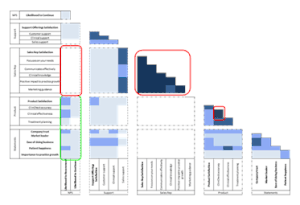
A prominent market research organization specializes in VOC (voice of customer) analysis, by administering focus groups and surveys. A recent client project arose, which required them to make recommendations on how to refine an existing VOC survey.
The research firm's client was in the dental industry, and used an annual survey to determine their overall NPS score. In other words, the client was most interested in their customer's “Likelihood to Recommend” the firm, and “Likelihood to Continue” using the product.
The purpose of the research firm’s project was to improve the survey questionnaire, by doing the following:
DSS had access to prior survey results, the questions, and supporting data sources. Based on the requirements of the project, we decided to apply the following steps to the problem:
Consolidate Questions: Explore the relationship between survey responses, in general and for different segments. This helps the market research firm determine which questions can be consolidated, in order to shorten the survey.
Determine NPS Predicters: Find which questions are the ideal predictors of NPS Likelihood measures. This ensures that the marketing research firm emphasizes the most important questions.
While many organizations are knowledgeable in regression, DSS knew that "linear regression" - the method most commonly taught and used in research projects - would be inappropriate, for the following reasons:
DSS recommended several questions that could be consolidated, thus improving the client's survey response rate. Additionally, we were able to recommend questions that should be expounded on, based on their relevance to NPS.
The results of this was a much higher accuracy rate, and a marked increase in survey responsiveness, and usefulness in application for other VOC analysis studies.

